Beneath the shimmering waters of the expansive freshwater rivers lies an extraordinary world that houses an assortment of fish species. Among these creatures lives a variety of freshwater sunfish, which are vibrant in color and exhibit captivating behaviors.
As guardians of the waters, they navigate relationships between predators and prey and foster the growth of other plants and animals. Furthermore, their conduct resembles intricate courtship practices to elaborate nest construction. Each movement tells a captivating tale of survival and reproduction.
So, hop on board as we embark on unlocking everything there is to know about different types of Sunfish, including each one ranked by size. Our journey will be one filled with unlocking details about their ecological importance to marveling at their immense adaptability – revealing a host of mysteries that have long intrigued marine biologists and curious minds alike.
Redbreast Sunfish (Lepomis auritus) 4-6 inches
The Redbreast Sunfish is found along the Atlantic coastline, from Florida shores to the Mississippi River Basin. It thrives in habitats with moderate to cool water conditions, particularly favoring areas with vegetation along shaded streams and rivers. Beyond their vibrant presence, these Sunfish are vital indicators of water body health and quality. Therefore, monitoring their population provides valuable insights for environmental maintenance.
The Redbreast Sunfish stands out with its vibrant orange or red breast area, creating an eye-catching contrast against a subdued olive to bronze-tone body complexion. Dark vertical stripes and a pointed pectoral fin add to its enchanting appearance, distinguishing it from other sunfish species.
Male Redbreast Sunfish possess remarkable nest-building abilities. During the breeding season, they demonstrate impressive skills by using plant materials to construct circular nests on riverbeds and lakes. These nests are defended against predators and rival males, ensuring successful reproduction. To ensure the well-being of their offspring, male fish diligently fan their fins, providing protection and oxygen for the unborn young. It’s a thoughtful effort to promote their offspring’s successful hatching and birth.
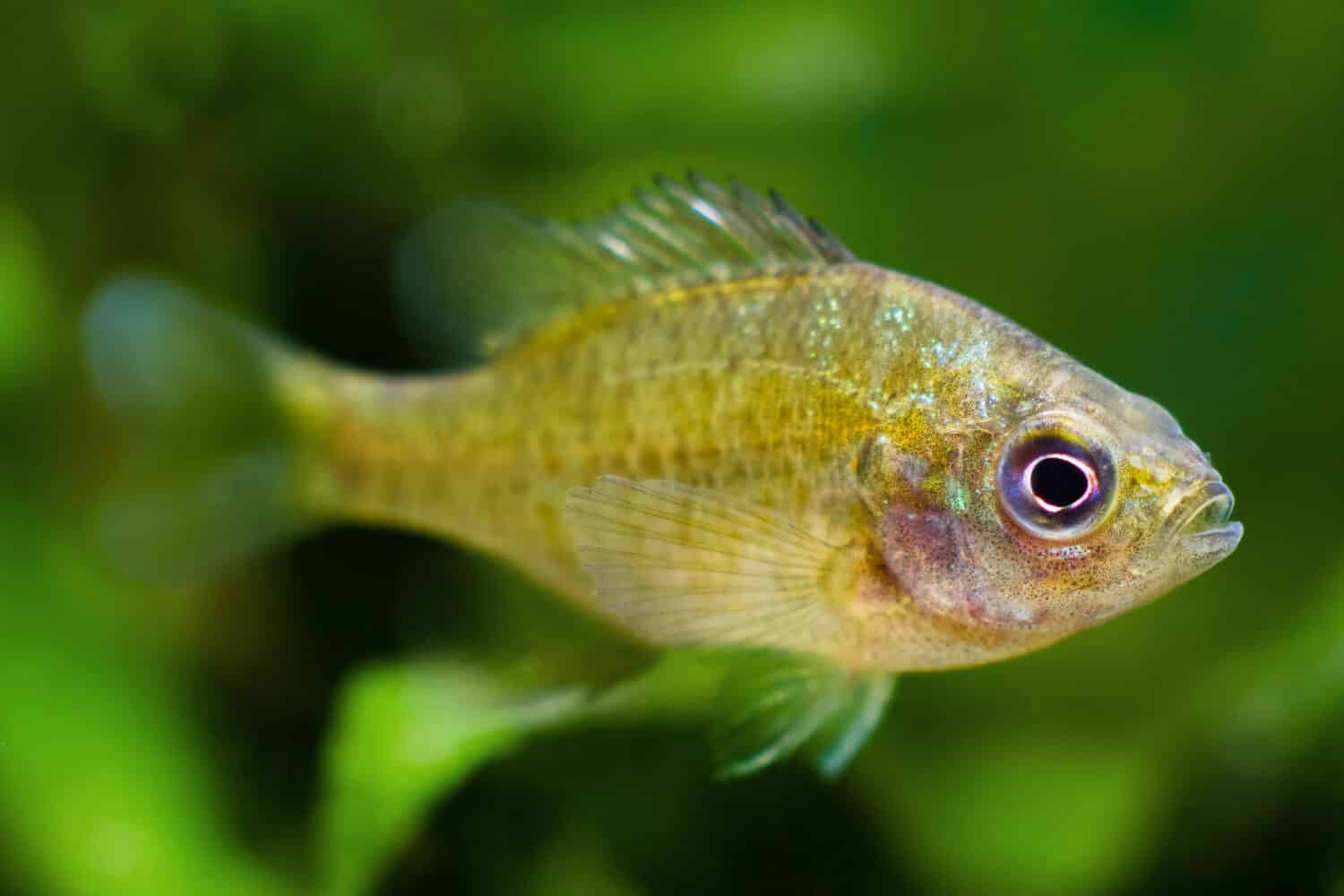
Lepomis auritus or Redbreast Sunfish has a subdued olive to bronze-tone body. Image: Aleron Val, Shutterstock
©Aleron Val/Shutterstock.com
Warmouth Sunfish (Lepomis gulosus) 4-9 inches
The Warmouth fish, another freshwater sunfish, is native to southeastern America and measures between 4 -7 inches in length. This fish is a predator, consuming various aquatic organisms like insects, crayfish, small fish, and invertebrates. Its physical traits include a wide mouth with sharp teeth, facilitating successful hunting. Warmouths display aggressive defensive behavior, particularly when competing for resources with other aquatic populations. Their fierce protectiveness leads them to confront both their own species and new organisms introduced to their environment.
The Warmouth sunfish has uneven pigmentation with rich tones of olive, brown, and yellow, featuring striking patterns of dark mottles on its fins and body. It also sports a red-orange patch near its tail, providing protection against other types of hunting fish. While Warmouths may not be as extensively targeted as other sunfish species, they still manage to capture the interest of leisurely fishing enthusiasts on occasion.
Bluegill Sunfish (Lepomis macrochirus) 7 inches
The bluegill fish, a popular panfish in North American waters, captivates fishing enthusiasts with its vibrant color palette of blue, green, and yellow. Its distinguishing feature is the striking opercular flap, adorned with a black color and a deep red or orange border. This eye-catching marking serves as a visual indicator for other fish and assists in attracting mates. Bluegills also possess sharp teeth, enabling them to prey on various aquatic organisms.
Bluegills, freshwater sunfish, are truly remarkable in their ability to thrive in diverse water conditions. They exhibit an extraordinary tolerance, adapting even to challenging environments with low oxygen levels or high turbidity. Bluegills exhibit social behavior during the egg-laying period, showcasing their communal nature. These fish are opportunistic eaters, consuming various meals, including insects, crustaceans, small fish, and vegetation. However, young Bluegill larvae feed on zooplankton in their early stages before transitioning to larger food sources.
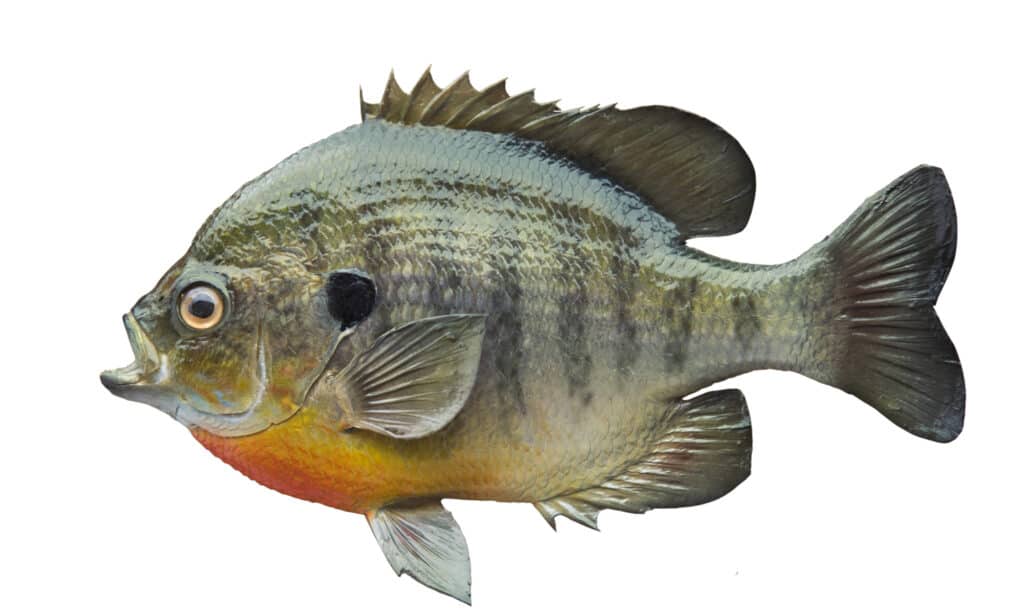
Bluegills are truly remarkable in their ability to thrive in diverse water conditions.
©Dan Thornberg/Shutterstock.com
Pumpkinseed Sunfish (Lepomis gibbosus) 7 inches
Originating from North America, the pumpkinseed sunfish’s name is well suited for its distinguishing physical attributes, specifically its resemblance to the shape of a pumpkin seed. These freshwater sunfish are a favored catch for recreational fishing due to their striking appearance and willingness to bite on various baits. Anglers value their spirited fights, deeming them a prized catch.
The pumpkinseed sunfish can adjust the saturation and tone of its scales. This remarkable attribute serves various purposes, including camouflage, communication, and defense against potential threats. With its laterally compressed structure, distinct dorsal fin, and relatively smaller mouth, this Sunfish showcases unique physical characteristics. Its vibrant color palette, ranging from orange and yellow to blue and green, adds to its allure. The pumpkinseed sunfish also features a striking red or orange spot on its gill cover, enhancing its already beautiful appearance.
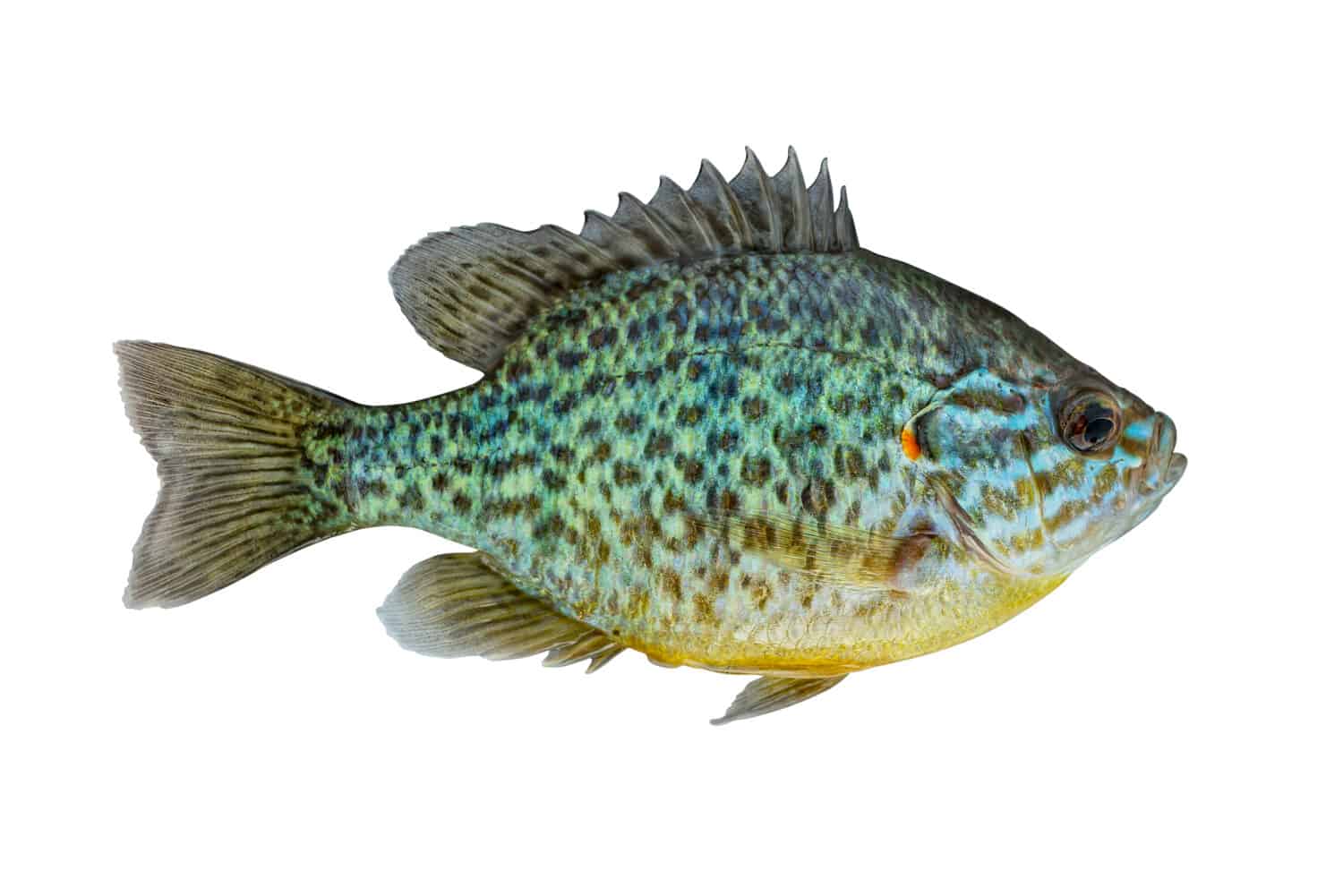
Pumpkinseed sunfish’s name is well suited for its distinguishing physical attributes, specifically its resemblance to the shape of a pumpkin seed. Image: FedBul, Shutterstock
©FedBul/Shutterstock.com
Longear Sunfish (Lepomis megalotis) -7 inches
The Longear Sunfish is naturally found in the central and eastern regions of the United States. Falling into the small fish category, they typically reach lengths of 4-7 inches and weigh around 2-5 ounces. Sporting an oval-shaped body, these Sunfish stand out with their distinctive elongated snout.
However, their most remarkable feature is the long ears that extend from their gill covers. Male Longear Sunfish utilize these striking ear extensions during the breeding season to captivate female fish. These Sunfish thrive in habitats with gentle currents, abundant vegetation growth, fallen logs, and overhanging branches, providing them with the necessary protection.
The Longear sunfish showcases stunning color patterns, with an olive to greenish-brown body complemented by vibrant turquoise markings. Its fins further enhance this natural artwork with rich orange and red tones. Alongside their captivating appearance, these Sunfish are known for their gentle and calm temperament. This makes them excellent additions to community aquariums and fascinating subjects to study in their native freshwater habitats.
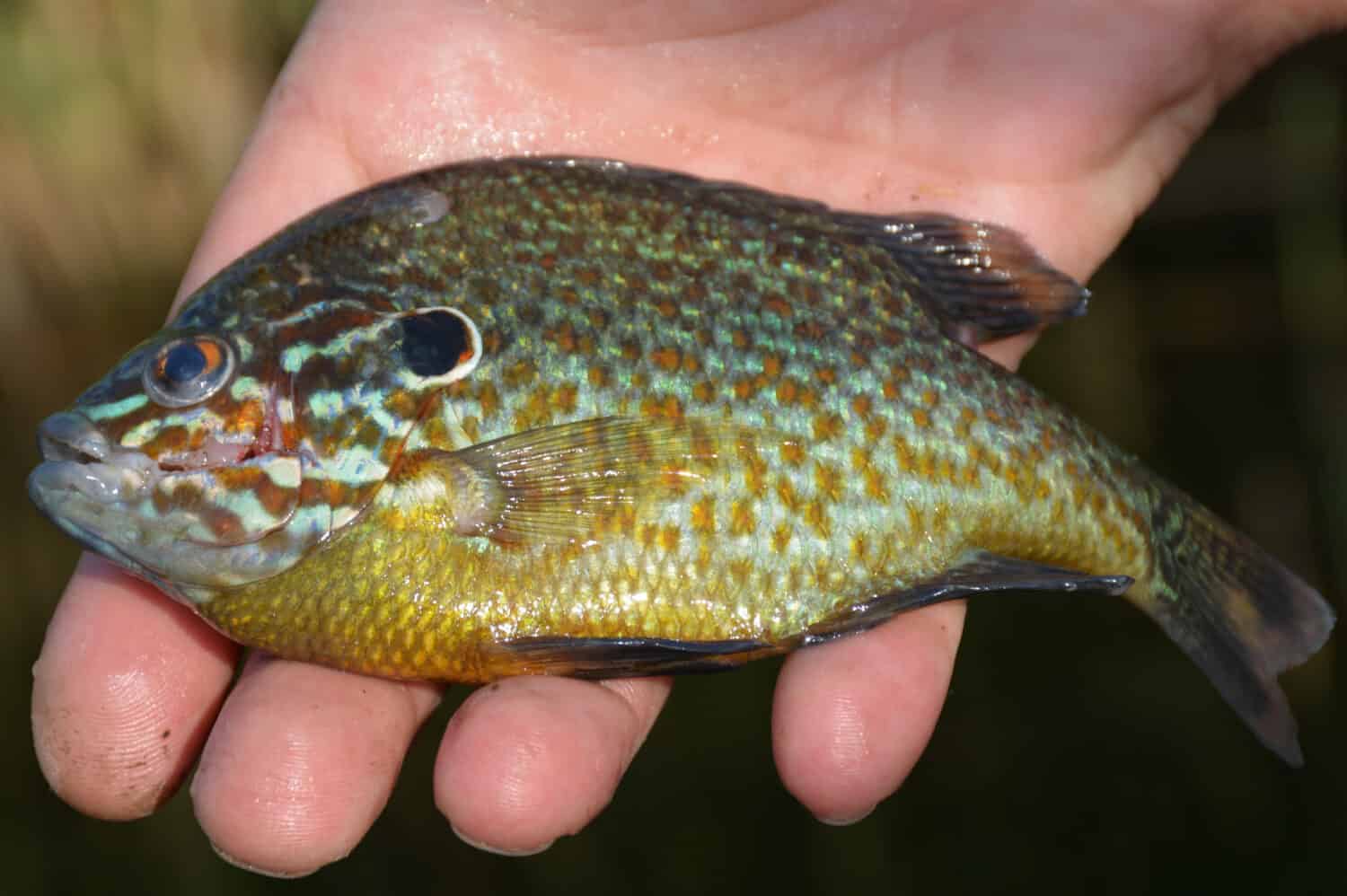
Longear Sunfish are known for their gentle and calm temperament.
©Self-taught/Shutterstock.com
Reddear Sunfish (Lepomis microlophus) 6-9 inches
The Redear Sunfish is a well-known North American freshwater fish that mainly resides in the southeastern-central region, including states like Texas, Florida, and Mississippi. This species has an interesting dietary preference as it primarily nourishes itself with snails along with other mollusks that are crucial in their nutrition. The name “Shellcracker” was given due to the specialized teeth and jaws that enable them to crack the tough shells of such prey.
Anglers value the Redear Sunfish for its size, making it a popular choice for both thrilling fishing experiences and delectable meals. In fact, this fish is a key contributor to preserving the ecological balance in freshwater ecosystems. It controls snail populations and serves as prey for larger predatory fish, playing a vital role in maintaining a healthy aquatic environment.
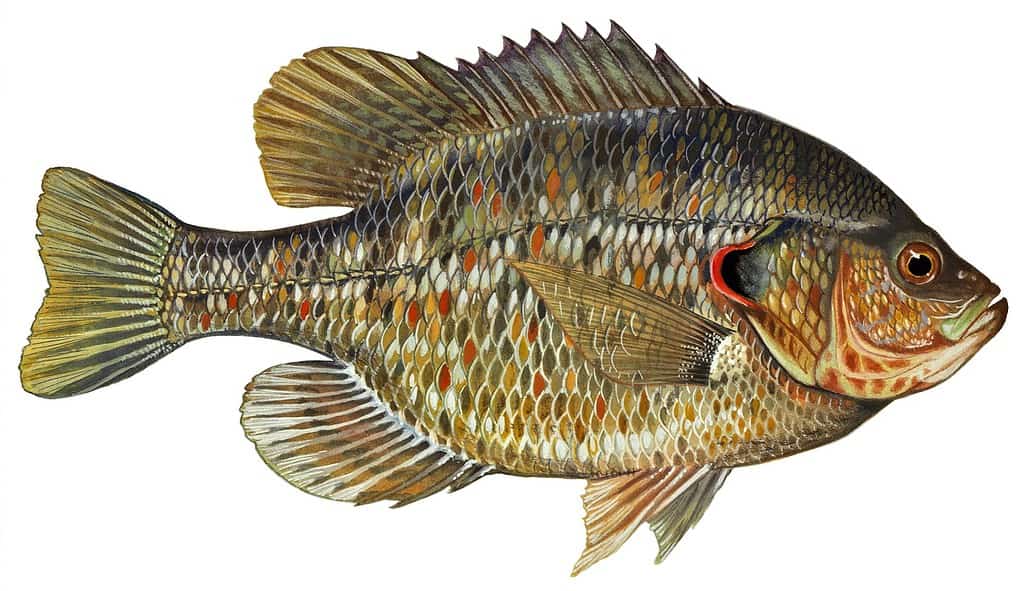
Redear sunfish (Lepomis microlophus) is valued for its size.
©Raver, Duane / Public domain – License
Green Sunfish (Lepomis cyanellus) 7-10 inches
The Green Sunfish is commonly referred to as a North American freshwater fish. These fish can be found dwelling within habitats surrounding numerous bodies of water. These include lakes, ponds, rivers, and streams spanning across the continent. The Green Sunfish grows up to an average length ranging from 4 to 7 inches and weighs 2.1 pounds. Depending on various factors, including age and environmental conditions, some specimens have been known to attain remarkable lengths of 12 inches.
Its most prominent traits include an olive-green tone which is complemented by hints of blue on both sides of its cheeks and operculum. Its body consists of mottled scales and lateral compressions, creating a flat-bodied structure. In addition, green Sunfish are opportunistic feeders, which allows them to adapt to many food sources, such as plant matter and small aquatic animals that include insects, crustaceans, and worms. Furthermore, Fishing enthusiasts prize the Green Sunfish for its aggressive behavior, as it presents a formidable challenge. The tenacity it demonstrates when hooked has established this species as an admired game fish across multiple territories.
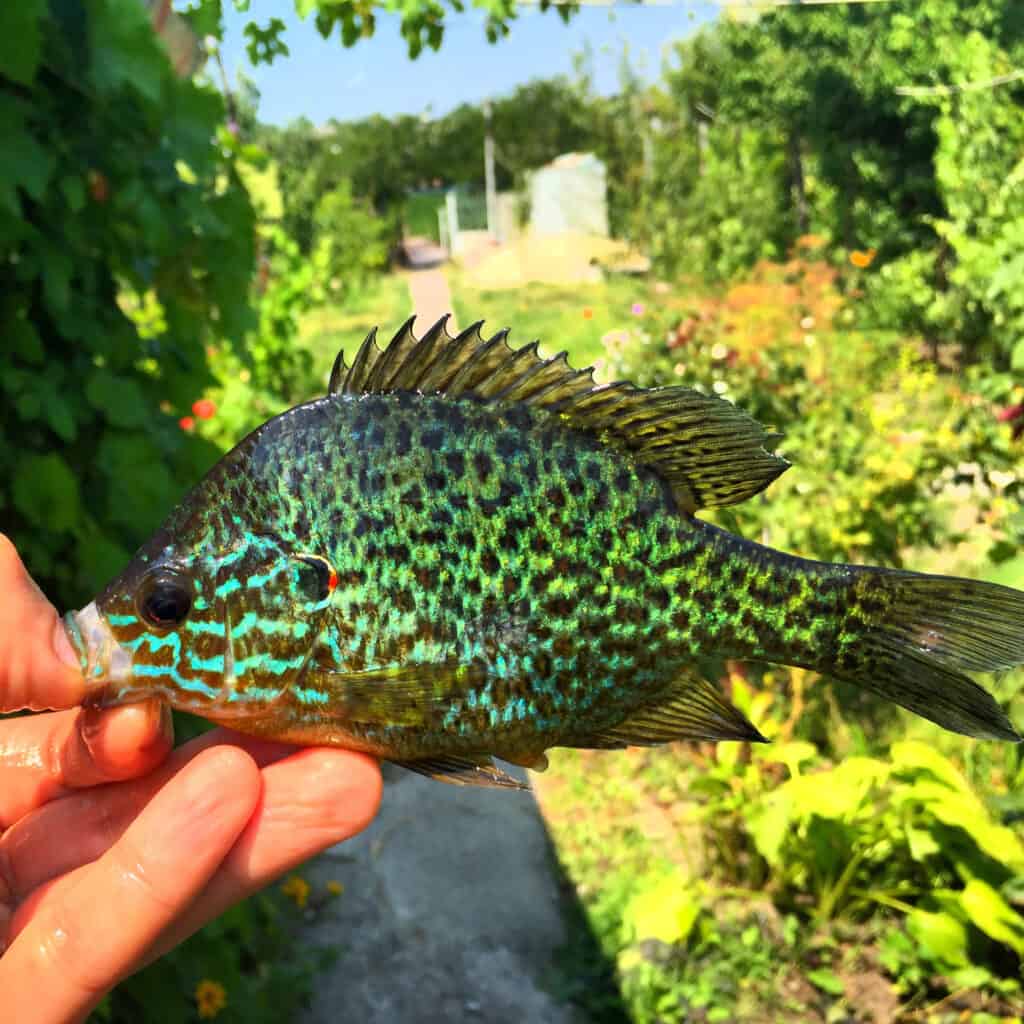
Green Sunfish is highly aggressive and predatory in nature.
©Pocket Draw/Shutterstock.com
Summary of the 7 Types of Sunfish Ranked by Size
Here is a list of the 7 Types of Sunfish Ranked by Size:
| Rank | Sunfish | Size |
|---|---|---|
| 1 | Redbreast Sunfish (Lepomis auritus) | 4-6 inches |
| 2 | Warmouth Sunfish (Lepomis gulosus) | 4-9 inches |
| 3 | Bluegill Sunfish (Lepomis macrochirus) | 7 inches |
| 4 | Pumpkinseed Sunfish (Lepomis gibbosus) | 7 inches |
| 5 | Longear Sunfish (Lepomis megalotis) | 7 inches |
| 6 | Reddear Sunfish (Lepomis microlophus) | 6-9 inches |
| 7 | Green Sunfish (Lepomis cyanellus) | 7-10 inches |
The photo featured at the top of this post is © Sean McVey/Shutterstock.com
Thank you for reading! Have some feedback for us? Contact the AZ Animals editorial team.







